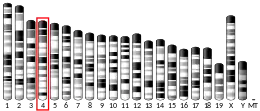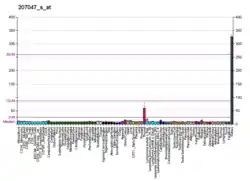CLCNKA
Chloride channel protein ClC-Ka is a protein that in humans is encoded by the CLCNKA gene. Multiple transcript variants encoding different isoforms have been found for this gene.[5][6]
Function
This gene is a member of the CLC family of voltage-gated chloride channels. The encoded protein is predicted to have 12 transmembrane domains, and requires a beta subunit called barttin to form a functional channel. It is thought to function in salt reabsorption in the kidney and potassium recycling in the inner ear. The gene is highly similar to CLCNKB, which is located 10 kb downstream from this gene.[6]
Gene variants
CLCNKA encodes one of the two major chloride channels found in the kidney, the ClC-Ka channel (the other class being the ClC-Kb from CLCNKB). The CLCNKA gene is subject, like all genes, to variation due to single-nucleotide polymorphisms (SNPs), in which a single base (A, T, C, or G) is randomly replaced by another base.[7] SNPs in the coding regions of CLCKNA may have consequent changes in the amino acid sequence of the ClC-Ka chloride channel leading to altered functional capacities and subsequent physiological alterations.[7]
Four SNPs (rs848307, rs1739843, rs1010069, and rs1805152) have been associated with increased salt-sensitivity by displaying an irregularly large increase in blood pressure following modest salt (Na+) intake, despite regular heart rate, blood pressure, and plasma renin levels before the salt ingestion.[7] Of particular interest is a common SNP leading to the amino acid Arginine at the 83rd position to be replaced by Glycine.[8] This variant is found to exist in approximately half of all caucasians, while a quarter of caucasians are homozygous for the allele.[8] Although mainly studied in the context of caucasians, the SNP actually exists with a greater frequency in people of African descent, where the gene frequency is 70%.[8] This SNP (rs10927887) was originally implicated in congestive heart failure after investigations into the heat shock protein HSPB7 showed that the CLCNKA gene was in linkage disequilibrium, meaning that the two genes are often not separated during recombination.[8] The CLCNKA variant was then shown to be the cause of the pathology.[8]
Pathology
The four SNPs found to be associated with salt sensitivity consequently predispose such cardiovascular problems as left ventricular hypertrophy and dysfunction of the endothelium.[7] The Arg83Gly SNP specifically results in a large reduction in the flow of chloride ions through the ClC-Ka channel in the thin and thick ascending limb of the nephrons.[8] Experimentally, the membrane potential at which the channels show no net movement of ions at a given chloride concentration drops significantly with the mutation, indicating altered function in situ.[8] This manifests as a chronic salt wasting disorder similar to Bartter syndrome,[8] as sodium reabsorption is coupled with chloride reabsorption.[7] The salt loss results in a decreased blood volume and consequently hyperreninemia leading (via the end product angiotensin II and aldosterone) to increased vascular tone, heart rate, water reabsorption, and blood pressure, collectively referred to as cardiorenal syndrome.[8] Being heterozygous for this Arg83Gly variant increases the risk of heart failure by 27%, while homozygosity increases the risk by 54%.[8] The additive stress on the heart from increased blood pressure and heart rate often only manifests as a pathology with an additional cardiovascular problem such as hypertension.[8] Treatment for the SNP associated hyperreninemia involves drugs to block the Renin-Angiotensin-Aldosterone system to relieve the aforementioned stresses on the heart.[8]
See also
- Chloride channel
- BSND, barttin, accessory subunit beta for this channel
References
- GRCh38: Ensembl release 89: ENSG00000186510 - Ensembl, May 2017
- GRCm38: Ensembl release 89: ENSMUSG00000006216 - Ensembl, May 2017
- "Human PubMed Reference:". National Center for Biotechnology Information, U.S. National Library of Medicine.
- "Mouse PubMed Reference:". National Center for Biotechnology Information, U.S. National Library of Medicine.
- Takeuchi Y, Uchida S, Marumo F, Sasaki S (Feb 1996). "Cloning, tissue distribution, and intrarenal localization of ClC chloride channels in human kidney". Kidney Int. 48 (5): 1497–503. doi:10.1038/ki.1995.439. PMID 8544406.
- "Entrez Gene: CLCNKA chloride channel Ka".
- Barlassina C, Dal Fiume C, Lanzani C, Manunta P, Guffanti G, Ruello A, Bianchi G, Del Vecchio L, Macciardi F, Cusi D (July 2007). "Common genetic variants and haplotypes in renal CLCNKA gene are associated to salt-sensitive hypertension". Hum. Mol. Genet. 16 (13): 1630–8. doi:10.1093/hmg/ddm112. PMID 17510212.
- Cappola TP, Matkovich SJ, Wang W, van Booven D, Li M, Wang X, Qu L, Sweitzer NK, Fang JC, Reilly MP, Hakonarson H, Nerbonne JM, Dorn GW (February 2011). "Loss-of-function DNA sequence variant in the CLCNKA chloride channel implicates the cardio-renal axis in interindividual heart failure risk variation". Proc. Natl. Acad. Sci. U.S.A. 108 (6): 2456–61. doi:10.1073/pnas.1017494108. PMC 3038744. PMID 21248228. Lay summary – University of Pennsylvania Health System.
Further reading
- Jentsch TJ, Günther W (1997). "Chloride channels: an emerging molecular picture". BioEssays. 19 (2): 117–26. doi:10.1002/bies.950190206. PMID 9046241. S2CID 19904492.
- Kieferle S, Fong P, Bens M, Vandewalle A, Jentsch TJ (1994). "Two highly homologous members of the ClC chloride channel family in both rat and human kidney". Proc. Natl. Acad. Sci. U.S.A. 91 (15): 6943–7. doi:10.1073/pnas.91.15.6943. PMC 44314. PMID 8041726.
- Maruyama K, Sugano S (1994). "Oligo-capping: a simple method to replace the cap structure of eukaryotic mRNAs with oligoribonucleotides". Gene. 138 (1–2): 171–4. doi:10.1016/0378-1119(94)90802-8. PMID 8125298.
- Saito-Ohara F, Uchida S, Takeuchi Y, Sasaki S, Hayashi A, Marumo F, Ikeuchi T (1997). "Assignment of the genes encoding the human chloride channels, CLCNKA and CLCNKB, to 1p36 and of CLCN3 to 4q32-q33 by in situ hybridization". Genomics. 36 (2): 372–4. doi:10.1006/geno.1996.0479. PMID 8812470.
- Suzuki Y, Yoshitomo-Nakagawa K, Maruyama K, Suyama A, Sugano S (1997). "Construction and characterization of a full length-enriched and a 5'-end-enriched cDNA library". Gene. 200 (1–2): 149–56. doi:10.1016/S0378-1119(97)00411-3. PMID 9373149.
- Estévez R, Boettger T, Stein V, Birkenhäger R, Otto E, Hildebrandt F, Jentsch TJ (2002). "Barttin is a Cl− channel beta-subunit crucial for renal Cl− reabsorption and inner ear K+ secretion". Nature. 414 (6863): 558–61. doi:10.1038/35107099. PMID 11734858. S2CID 4407807.
- Schlingmann KP, Konrad M, Jeck N, Waldegger P, Reinalter SC, Holder M, Seyberth HW, Waldegger S (2004). "Salt wasting and deafness resulting from mutations in two chloride channels". N. Engl. J. Med. 350 (13): 1314–9. doi:10.1056/NEJMoa032843. PMID 15044642.
- Scholl U, Hebeisen S, Janssen AG, Müller-Newen G, Alekov A, Fahlke C (2006). "Barttin modulates trafficking and function of ClC-K channels". Proc. Natl. Acad. Sci. U.S.A. 103 (30): 11411–6. doi:10.1073/pnas.0601631103. PMC 1544099. PMID 16849430.
- Barlassina C, Dal Fiume C, Lanzani C, Manunta P, Guffanti G, Ruello A, Bianchi G, Del Vecchio L, Macciardi F, Cusi D (2007). "Common genetic variants and haplotypes in renal CLCNKA gene are associated to salt-sensitive hypertension". Hum. Mol. Genet. 16 (13): 1630–8. doi:10.1093/hmg/ddm112. PMID 17510212.
- Markovic S, Dutzler R (2007). "The structure of the cytoplasmic domain of the chloride channel ClC-Ka reveals a conserved interaction interface". Structure. 15 (6): 715–25. doi:10.1016/j.str.2007.04.013. PMID 17562318.
External links
- CLCNKA+protein,+human at the US National Library of Medicine Medical Subject Headings (MeSH)
- Human CLCNKA genome location and CLCNKA gene details page in the UCSC Genome Browser.
This article incorporates text from the United States National Library of Medicine, which is in the public domain.





